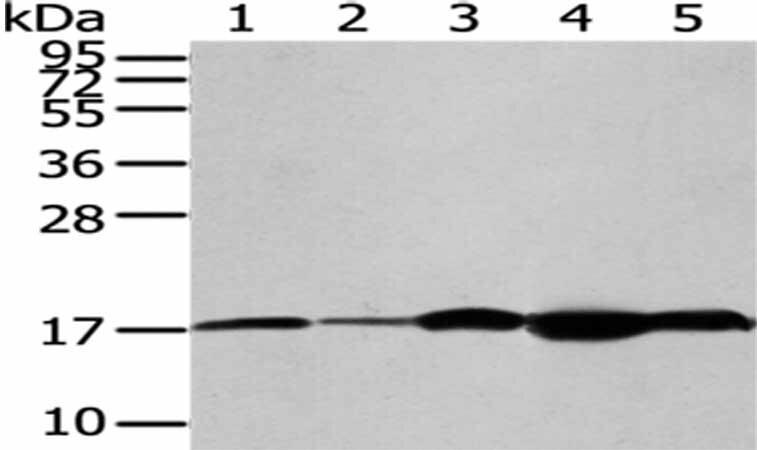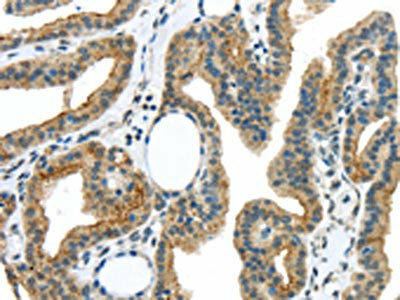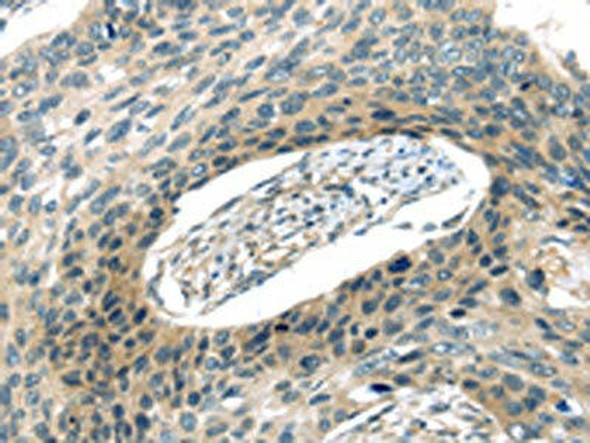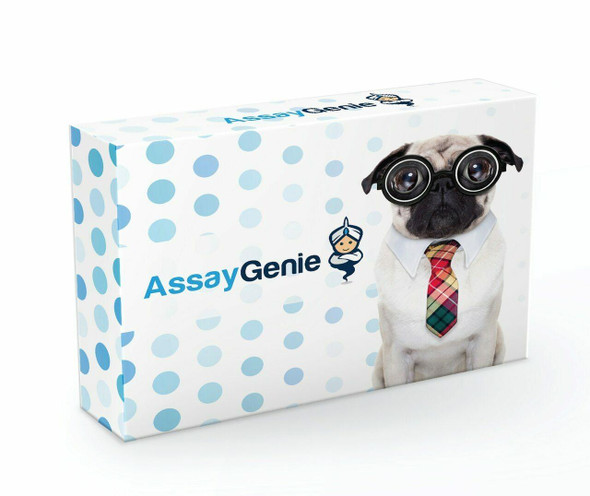Description
VAMP2 Antibody (PACO20850)
Based on the information provided in the URL provided (https://www.assaygenie.com/vamp2-antibody-paco20850/), the VAMP2 Antibody (PACO20850) is a high-quality polyclonal antibody designed for research involving VAMP2, a protein involved in membrane fusion and neurotransmitter release. The antibody, produced in rabbits, exhibits high reactivity with human samples and has been validated for use in Western blot and immunofluorescence applications.VAMP2, also known as synaptobrevin-2, is a critical component of the SNARE complex that mediates synaptic vesicle fusion with the plasma membrane in neurons. Its role in neurotransmission makes it a key target for studies in neuroscience and neurology.
By targeting VAMP2, researchers can investigate synaptic function, synaptic plasticity, and the molecular mechanisms underlying neurological disorders such as Alzheimer's disease and Parkinson's disease.The VAMP2 Antibody (PACO20850) enables specific detection and analysis of VAMP2 protein expression in various cell types and tissue samples, making it a valuable tool for researchers interested in understanding synaptic vesicle trafficking and neurotransmitter release. Its high specificity and sensitivity make it ideal for use in both basic research and drug discovery efforts aimed at developing novel therapies for neurological conditions.
| Antibody Name: | VAMP2 Antibody (PACO20850) |
| Antibody SKU: | PACO20850 |
| Size: | 50ul |
| Host Species: | Rabbit |
| Tested Applications: | ELISA, WB, IHC |
| Recommended Dilutions: | ELISA:1:2000-1:5000, WB:1:500-1:2000, IHC:1:25-1:100 |
| Species Reactivity: | Human, Mouse, Rat |
| Immunogen: | Synthetic peptide of human VAMP2 |
| Form: | Liquid |
| Storage Buffer: | -20°C, pH7.4 PBS, 0.05% NaN3, 40% Glycerol |
| Purification Method: | Antigen affinity purification |
| Clonality: | Polyclonal |
| Isotype: | IgG |
| Conjugate: | Non-conjugated |
 | The image on the left is immunohistochemistry of paraffin-embedded Human esophagus cancer tissue using PACO20850(VAMP2 Antibody) at dilution 1/40, on the right is treated with synthetic peptide. (Original magnification: x200). |
 | Gel: 12%SDS-PAGE,Lysate: 40 µg,Lane 1-5: A172 cells, Jurkat cells, Hela cells, Mouse brain tissue, Human fetal brain tissue,Primary antibody: PACO20850(VAMP2 Antibody) at dilution 1/200 dilution,Secondary antibody: Goat anti rabbit IgG at 1/8000 dilution,Exposure time: 30 seconds. |
 | The image on the left is immunohistochemistry of paraffin-embedded Human thyroid cancer tissue using PACO20850(VAMP2 Antibody) at dilution 1/40, on the right is treated with synthetic peptide. (Original magnification: x200). |
| Background: | The protein encoded by this gene is a member of the vesicle-associated membrane protein (VAMP)/synaptobrevin family. Synaptobrevins/VAMPs, syntaxins, and the 25-kD synaptosomal-associated protein SNAP25 are the main components of a protein complex involved in the docking and/or fusion of synaptic vesicles with the presynaptic membrane. This gene is thought to participate in neurotransmitter release at a step between docking and fusion. The protein forms a stable complex with syntaxin, synaptosomal-associated protein, 25 kD, and synaptotagmin. It also forms a distinct complex with synaptophysin. It is a likely candidate gene for familial infantile myasthenia (FIMG) because of its map location and because it encodes a synaptic vesicle protein of the type that has been implicated in the pathogenesis of FIMG. |
| Synonyms: | vesicle-associated membrane protein 2 (synaptobrevin 2) |
| UniProt Protein Function: | VAMP2: a member of the vesicle-associated membrane protein (VAMP)/synaptobrevin family. Synaptobrevins/VAMPs, syntaxins, and the 25-kD synaptosomal-associated protein SNAP25 are the main components of a protein complex involved in the docking and/or fusion of synaptic vesicles with the presynaptic membrane. Thought to participate in neurotransmitter release at a step between docking and fusion. The protein forms a stable complex with syntaxin, synaptosomal-associated protein, 25 kD, and synaptotagmin. It also forms a distinct complex with synaptophysin. |
| UniProt Protein Details: | Protein type:Motility/polarity/chemotaxis; Vesicle; Membrane protein, integral Chromosomal Location of Human Ortholog: 17p13.1 Cellular Component: zymogen granule membrane; neuron projection; synaptic vesicle membrane; intracellular membrane-bound organelle; clathrin-coated vesicle; integral to plasma membrane; secretory granule membrane; trans-Golgi network; cytosol; secretory granule; SNARE complex; synaptic vesicle; membrane; perinuclear region of cytoplasm; plasma membrane; synapse; cytoplasmic vesicle; cell junction Molecular Function:calmodulin binding; SNAP receptor activity; protein binding; SNARE binding; protein self-association; syntaxin binding; syntaxin-1 binding; phospholipid binding; calcium-dependent protein binding Biological Process: exocytosis; natural killer cell degranulation; neurotransmitter secretion; neutrophil degranulation; pathogenesis; calcium ion-dependent exocytosis; vesicle fusion; regulation of exocytosis; vesicle-mediated transport; synaptic transmission; protein transport; synaptic vesicle exocytosis; cellular protein metabolic process; glutamate secretion; cellular response to insulin stimulus; Golgi to plasma membrane protein transport; response to glucose stimulus; energy reserve metabolic process; eosinophil degranulation; protein complex assembly; post-Golgi vesicle-mediated transport; regulation of insulin secretion |
| NCBI Summary: | The protein encoded by this gene is a member of the vesicle-associated membrane protein (VAMP)/synaptobrevin family. Synaptobrevins/VAMPs, syntaxins, and the 25-kD synaptosomal-associated protein SNAP25 are the main components of a protein complex involved in the docking and/or fusion of synaptic vesicles with the presynaptic membrane. This gene is thought to participate in neurotransmitter release at a step between docking and fusion. The protein forms a stable complex with syntaxin, synaptosomal-associated protein, 25 kD, and synaptotagmin. It also forms a distinct complex with synaptophysin. It is a likely candidate gene for familial infantile myasthenia (FIMG) because of its map location and because it encodes a synaptic vesicle protein of the type that has been implicated in the pathogenesis of FIMG. [provided by RefSeq, Jul 2008] |
| UniProt Code: | P63027 |
| NCBI GenInfo Identifier: | 288558837 |
| NCBI Gene ID: | 6844 |
| NCBI Accession: | P63027.3 |
| UniProt Secondary Accession: | P63027,P19065, Q9BUC2, |
| UniProt Related Accession: | P63027 |
| Molecular Weight: | 13kDa |
| NCBI Full Name: | Vesicle-associated membrane protein 2 |
| NCBI Synonym Full Names: | vesicle-associated membrane protein 2 (synaptobrevin 2) |
| NCBI Official Symbol: | VAMP2 |
| NCBI Official Synonym Symbols: | SYB2; VAMP-2 |
| NCBI Protein Information: | vesicle-associated membrane protein 2; synaptobrevin 2; synaptobrevin-2; vesicle associated membrane protein 2 |
| UniProt Protein Name: | Vesicle-associated membrane protein 2 |
| UniProt Synonym Protein Names: | Synaptobrevin-2 |
| Protein Family: | Vesicle-associated membrane protein |
| UniProt Gene Name: | VAMP2 |
| UniProt Entry Name: | VAMP2_HUMAN |













